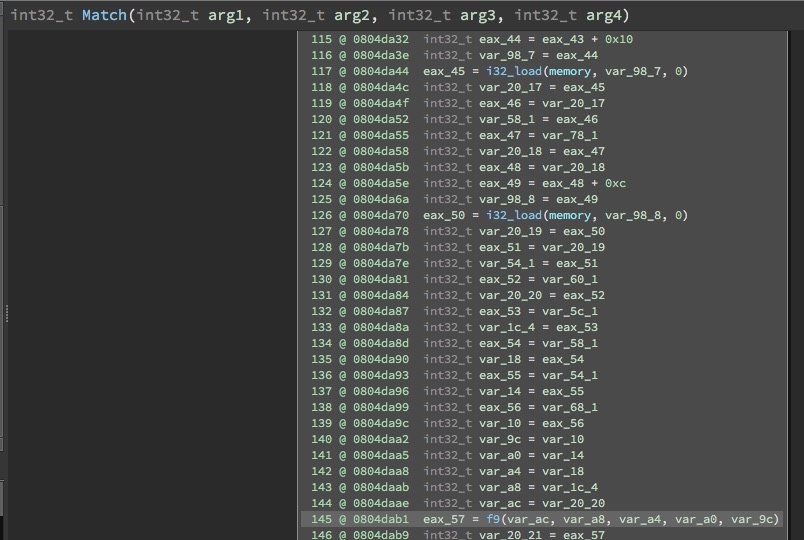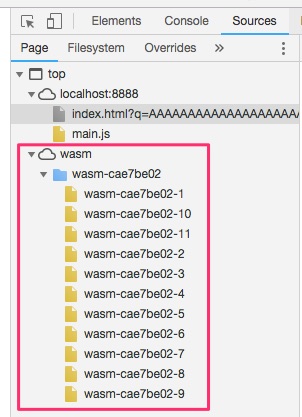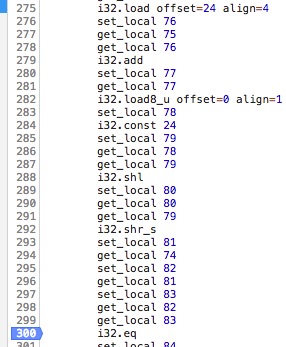FlareOn 2018 Level 5 - Solving WebAssembly Crackme (Part I - Recompilation and Chrome)
Level 5 of FlareOn 2018 was a WebAssembly crackme challenge where we were handed a compiled wasm file and told to extract the password. Here we will look into two different ways of solving this challenge: ReCompilation to x86 (this blog post) and using a new dynamic-analysis framework called Wasabi (next blog post).
Recon
We begin with 3 files provided by the organizers:
$ ls
index.html main.js test.wasm
The index.html is simply a loader for the main.js file:
<!DOCTYPE html>
<html>
<head>
<meta charset='utf-8'>
<style>
</style>
</head>
<body>
<span id="container"></span>
<script src="./main.js"></script>
</body>
</html>
The main.js is the file that will instantiate the test.wasm file. This is effectively loading the test.wasm file and calling a given export from the file.
fetch("test.wasm").then(response =>
response.arrayBuffer()
).then(bytes =>
WebAssembly.instantiate(bytes, {
...
The crux of the main.js is below:
let a = new Uint8Array([
0xE4, 0x47, 0x30, 0x10, 0x61, 0x24, 0x52, 0x21, 0x86, 0x40, 0xAD, 0xC1, 0xA0, 0xB4, 0x50, 0x22, 0xD0, 0x75, 0x32, 0x48, 0x24, 0x86, 0xE3, 0x48, 0xA1, 0x85, 0x36, 0x6D, 0xCC, 0x33, 0x7B, 0x6E, 0x93, 0x7F, 0x73, 0x61, 0xA0, 0xF6, 0x86, 0xEA, 0x55, 0x48, 0x2A, 0xB3, 0xFF, 0x6F, 0x91, 0x90, 0xA1, 0x93, 0x70, 0x7A, 0x06, 0x2A, 0x6A, 0x66, 0x64, 0xCA, 0x94, 0x20, 0x4C, 0x10, 0x61, 0x53, 0x77, 0x72, 0x42, 0xE9, 0x8C, 0x30, 0x2D, 0xF3, 0x6F, 0x6F, 0xB1, 0x91, 0x65, 0x24, 0x0A, 0x14, 0x21, 0x42, 0xA3, 0xEF, 0x6F, 0x55, 0x97, 0xD6
]);
let b = new Uint8Array(new TextEncoder().encode(getParameterByName("q")));
let pa = wasm_alloc(instance, 0x200);
wasm_write(instance, pa, a);
let pb = wasm_alloc(instance, 0x200);
wasm_write(instance, pb, b);
if (instance.exports.Match(pa, a.byteLength, pb, b.byteLength) == 1) {
// PARTY POPPER - Success
} else {
// PILE OF POO - Fail
}
Some piece of ciphertext is allocated via wasm_alloc as well as the input passed by the q parameter. These two sections of data are passed to the Match function exported from test.wasm. We can see this is the Match function via instance.exports.Match. Our goal is to reverse the Match function in order for it to return 1.
Disassembling WASM
We can leverage the low-level tools provided by WebAssembly called wabt to begin analysis of test.wasm. Let’s begin with building the tools.
$ git clone --recursive https://github.com/WebAssembly/wabt
$ cd wabt
$ make
The tools can be found in ./out/clang/Debug. We can confirm that the Match function is actually an exported function from test.wasm.
$ ./out/clang/Debug/wasm-objdump -x -j Export ./test.wasm
test.orig.wasm: file format wasm 0x1
Section Details:
Export[6]:
- func[48] <Match> -> "Match"
- func[49] <writev_c> -> "writev_c"
- table[0] -> "__wasabi_table"
- memory[0] -> "memory"
- global[1] -> "__heap_base"`
- global[2] -> "__data_end"
From here, we could begin analyzing the disassembly at the Match function.
$ ./out/clang/Debug/wasm-objdump -j Code -d ./test.wasm | rg -A10 Match
005ecf <Match>:
005ed2: 4b 7f | local[0..74] type=i32
005ed4: 41 0a | i32.const 10
005ed6: 41 7f | i32.const 4294967295
005ed8: 10 01 | call 1 <begin_function>
005eda: 23 00 | get_global 0
005edc: 41 0a | i32.const 10
005ede: 41 00 | i32.const 0
005ee0: 41 00 | i32.const 0
005ee2: 23 00 | get_global 0
005ee4: 10 02 | call 2 <get_global_i>
005ee6: 21 04 | set_local 4
005ee8: 41 0a | i32.const 10
005eea: 41 01 | i32.const 1
005eec: 41 04 | i32.const 4
005eee: 20 04 | get_local 4
005ef0: 10 03 | call 3 <set_local_i>
005ef2: 41 20 | i32.const 32
005ef4: 41 0a | i32.const 10
005ef6: 41 02 | i32.const 2
005ef8: 41 20 | i32.const 32
While this objdump output can definitely be analyzed, we can do better. Using the same wabt tools, we can recompile this wasm into x86, which is a bit easier to read. The wasm2c tool can be used to create an extensive .c file.
# Create test.c
./out/clang/Debug/wasm2c test.wasm -o test.c
With the test.c, we can then compile with the headers provided by wabt.
# Create binary
gcc -m32 -o flareon_level5 -I$PWD/wasm2c wasm2c/wasm-rt-impl.c test.c
We now have a binary that we can analyze. The goal here is to reverse a bit and then leverage a browser debugger to possibly gain runtime information about what is being checked. Note that this compilation is not optimized, because optimizations will make it a bit harder to go back to the wasm for setting breakpoints in the debugger.
In Binary Ninja, we now have a binary that looks something like the following:

In Hex Rays, we have something like the following:

This gives us the ability to rename variables, add struct types, ect making it just a bit easier to reverse.
We can see the main function that Match calls is f9. This function must be doing the bulk of the analysis. In f9 there is a data processing loop that calls some dynamic function. The result of this function is then compared with a memory value:

There are usually two possible conditions for crackmes like this that we can use to make a further assumption:
- The ciphertext is decoded and then the plaintext is checked in memory
- The password is encoded and the encoded password is checked against the ciphertext in memory
The first is easier to check of the two. If we assume this comparison is actually a case of the first bullet point, a simple breakpoint at the comparison will tell us the password. With this test in mind, we need to go backwards from the x86 to the wasm to find a useful breakpoint.
Here we use context clues to give us an interesting breakpoint location.
v19 = i32_load(&memory, v32 + 24, 0) + v18;
if ( v16 == (char)i32_load8_u(&memory, v19, 0) )
We want to look for an instance of i32_load8_u that comes after a i32.load with offset=24. This could be found with objdump like before, but in practice, I simply looked in Chrome for this pattern and set a breakpoint.
To debug this in Chrome, start a simple HTTP server in the folder where the problem files are located:
$ ls
index.html main.js test.wasm web2point0.7z
$ python -m SimpleHTTPServer 8888
Serving HTTP on 0.0.0.0 port 8888 ...
In Chrome, navigate to http://localhost:8888/index.html?q=QQQQQQQQQQQQQQQQQQQQQQQQQQQQQQQQQQQQ to start the problem with some value in q.
Chrome comes with a WASM debugger. Right-click and click on Inspect on the page after it is loaded and click on the Sources tab.

We can also see the various functions called by test.wasm that Chrome gives us as well.

Using our reversing knowledge, we can go into f9 and look for that particular i32_load8_u.

Clicking on the 300 number will set a breakpoint on this instruction. We can now throw our Q string to see if those Qs are being directly compared against the (assumed) decrypted string.

The contents of the stack we see are 119 (or w) and 81 (or Q). Continuing from this breakpoint 5 times, we end up with wasm_. This gives us higher hopes that we are on the right path. By continuing and recording the stack at each iteration we eventually conclude with the flag:
a = [119, 97, 115, 109, 95, 114, 117, 108, 101, 122, 95, 106, 115, 95, 100, 114, 111, 111, 108, 122, 64, 102, 108, 97, 114, 101, 45, 111, 110, 46, 99, 111, 109]
print(''.join(chr(x) for x in a))
'wasm_rulez_js_droolz@flare-on.com'
git clone https://github.com/ctfhacker/ctf-writeups